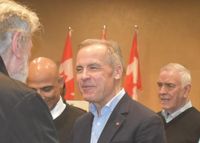As Canada prepares for a federal election on April 28, 2025, the political landscape has shifted dramatically from the beginning of the year. Initially, the Conservative Party was poised for a significant victory, buoyed by support from more than half of decided voters in Ontario and British Columbia. However, with the recent leadership change in the Liberal Party and evolving voter sentiments, the dynamics have changed.
Mark Carney, the new Liberal leader and prime minister, has garnered considerable approval since taking office. A Research Co. poll conducted on March 23 and 24 shows that 41 percent of decided voters now support the Liberals, while 37 percent back the Conservatives. This marks a notable shift from earlier predictions, indicating that voters are reassessing their choices as the election date approaches.
Other parties are struggling to gain traction in the polls, with the New Democratic Party (NDP) at nine percent, the Bloc Québécois at seven percent, the Green Party at three percent, and the People’s Party at two percent. The NDP, in particular, is facing challenges, retaining only 58 percent of its voters from the 2021 election, with their support in British Columbia dropping to eight percent.
Meanwhile, the Bloc Québécois has seen its support plummet from 34 percent in early January to just 22 percent in late March, as voters in Quebec reconsider the implications of sovereignty amid national stability concerns. The Liberals are currently leading in Quebec with 43 percent support, tied with the Conservatives.
The shifting priorities of Canadian voters are also evident in the issues they find most important. Canada-U.S. relations have emerged as the top concern for 30 percent of Canadians, followed by the economy and jobs at 20 percent, and housing, homelessness, and poverty at 17 percent. This change in focus has influenced the tone of the campaign, with Carney and Poilievre addressing these issues in their rallies.
Carney's handling of his duties has received a positive response, with 57 percent of Canadians approving of his leadership, a significant improvement from former Prime Minister Justin Trudeau’s approval rating of 34 percent. In contrast, Conservative Leader Pierre Poilievre has seen a drop in his approval rating to 46 percent, down six points from earlier in the campaign.
As the election campaign progresses, voter turnout is also a critical factor. Historically, turnout has been declining, with only 62.2 percent of Canadians participating in the 2021 federal election. However, there is a sense that this election could see increased participation, particularly among younger voters who may be motivated by issues like housing and the economy. For Canadians aged 18-34, housing is the most pressing issue, with 24 percent identifying it as their primary concern.
In response to declining voter engagement, various proposals have been put forward to make voting more accessible, including online voting and initiatives aimed at engaging young voters. The Conference Board of Canada has suggested that simplifying the voting process and emphasizing its relevance can help increase participation.
On the campaign trail, Poilievre has been addressing concerns about his leadership and the future of social programs. He has assured voters that under a Conservative government, programs like dental care and pharmacare will be protected. “We will protect these programs, and no one who has them will lose them,” Poilievre stated during a rally, attempting to counter criticisms from the Liberal and NDP camps.
However, NDP Leader Jagmeet Singh has challenged Poilievre's assurances, labeling them as deceptive and warning voters not to trust his promises. Singh's criticisms reflect a broader concern among voters regarding the Conservative Party's commitment to social programs that many Canadians rely on.
In addition to social programs, the looming threat of tariffs imposed by U.S. President Donald Trump has become a focal point for both Poilievre and Carney. Trump has announced plans to impose reciprocal tariffs starting April 2, 2025, which could have significant repercussions for Canadian industries, particularly in the auto sector. This has led to heightened discussions on trade policies and economic management, with both leaders attempting to position themselves as the best option to navigate these challenges.
The Sault Ste. Marie Chamber of Commerce has voiced support for the Ontario Chamber of Commerce’s four-point plan, which emphasizes the need for a competitive business environment and the importance of trade agreements. The plan calls for strengthening the Canadian Free Trade Agreement and addressing the impact of tariffs on local industries like Algoma Steel.
As the election approaches, the focus on economic priorities and trade relations will likely intensify. The Ontario Chamber of Commerce has urged political parties to incorporate plans for sustainable communities and health care improvements in their platforms. With trade and economic stability at the forefront of voters’ minds, the candidates will need to address these issues head-on to win support.
As the campaign continues, the candidates are navigating a complex landscape filled with shifting voter priorities, economic uncertainties, and heightened scrutiny over their leadership capabilities. With Ontario being a critical battleground for the election, the actions and messages delivered by Carney, Poilievre, and Singh in the coming weeks will be crucial in shaping the outcome of this pivotal election.







